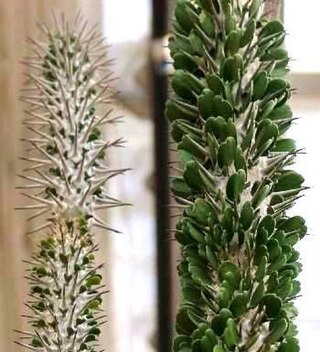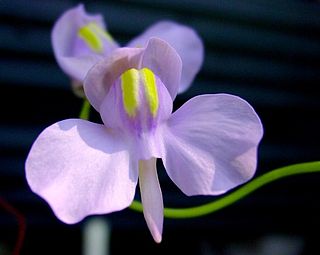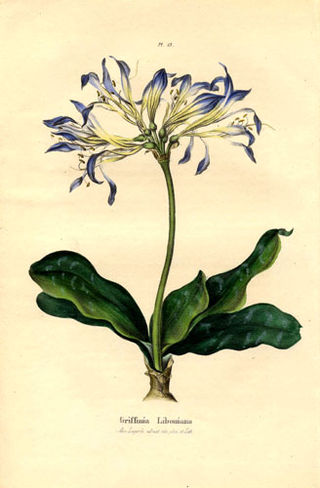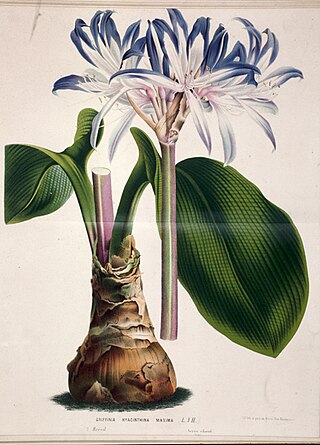
Melaleuca is a genus of nearly 300 species of plants in the myrtle family, Myrtaceae, commonly known as paperbarks, honey-myrtles or tea-trees. They range in size from small shrubs that rarely grow to more than 16 m (52 ft) high, to trees up to 35 m (115 ft). Their flowers generally occur in groups, forming a "head" or "spike" resembling a brush used for cleaning bottles, containing up to 80 individual flowers.

Boronia is a genus of about 160 species of flowering plants in the citrus family Rutaceae. Most are endemic to Australia with a few species in New Caledonia, which were previously placed in the genus Boronella. They occur in all Australian states but the genus is under review and a number of species are yet to be described or have the description published. Boronias are similar to familiar plants in the genera Zieria, Eriostemon and Correa but can be distinguished from them by the number of petals or stamens. Some species have a distinctive fragrance and are popular garden plants.

Alstroemeriaceae is a family of flowering plants, with 254 known species in four genera, almost entirely native to the Americas, from Central America to southern South America. One species of Luzuriaga occurs in New Zealand, and the genus Drymophila is endemic to south-eastern Australia.

Grevillea, commonly known as spider flowers, is a genus of about 360 species of evergreen flowering plants in the family Proteaceae. Plants in the genus Grevillea are shrubs, rarely trees, with the leaves arranged alternately along the branches, the flowers zygomorphic, arranged in racemes at the ends of branchlets, and the fruit a follicle that splits down one side only, releasing one or two seeds.

Didiereaceae is a family of flowering plants found in continental Africa and Madagascar. It contains 20 species classified in three subfamilies and six genera. Species of the family are succulent plants, growing in sub-arid to arid habitats. Several are known as ornamental plants in specialist succulent collections. The subfamily Didiereoideae is endemic to the southwest of Madagascar, where the species are characteristic elements of the spiny thickets.

Eremophila is a genus of more than 260 species of plants in the figwort family, Scrophulariaceae all of which are endemic to mainland Australia.. Eremophilas are widespread in the arid areas of Australia, especially Western Australia and range in size from low-growing shrubs to small trees. The petals are joined, at least at their bases, into a tube with the upper petals different in size and shape from the lower ones. Some species have common names including emu bush, poverty bush or fuchsia bush, reflecting the belief that emus eat the fruit, their arid environment or a superficial resemblance to the flowers of plants in the genus Fuchsia.

Caladenia, commonly known as spider orchids, is a genus of 350 species of plants in the orchid family, Orchidaceae. Spider orchids are terrestrial herbs with a single hairy leaf and a hairy stem. The labellum is fringed or toothed in most species and there are small projections called calli on the labellum. The flowers have adaptations to attract particular species of insects for pollination. The genus is divided into three groups on the basis of flower shape, broadly, spider orchids, zebra orchids and cowslip orchids, although other common names are often used. Although they occur in other countries, most are Australian and 136 species occur in Western Australia, making it the most species-rich orchid genus in that state.

Pultenaea is a genus of about 100 species of flowering plants in the family Fabaceae, and is endemic to Australia. Plants in this genus are shrubs with simple leaves and orange or yellow flowers similar to others in the family but with the standard petal equal to or slightly longer than the other petals.

Chamelaucium, also known as waxflower, is a genus of shrubs endemic to south western Western Australia. They belong to the myrtle family Myrtaceae and have flowers similar to those of the tea-trees (Leptospermum). The most well-known species is the Geraldton wax, Chamelaucium uncinatum, which is cultivated widely for its large attractive flowers.

Goodenia is a genus of about two hundred species of flowering plants in the family Goodeniaceae. Plants in this genus are herbs or shrubs, mostly endemic to Australia. The leaves are variably-shaped, the flowers arranged in small groups, with three or five sepals, the corolla bilaterally symmetrical and either fan-shaped with two "lips" or tube-shaped. The petals are usually yellow to white, the stamens free from each other and the fruit a capsule.

Gonialoe sladeniana is a species of plant in the genus Gonialoe. It is endemic to arid areas of central Namibia.

Utricularia nelumbifolia is a large perennial aquatic carnivorous plant that belongs to the genus Utricularia. U. nelumbifolia is endemic to Brazil. It was originally published and described by George Gardner in 1842. Its habitat is reported as being restricted to the water-filled leaf axils of Vriesea species, which are bromeliads, in arid volcanic locations at altitudes from 800 m (2,625 ft) to 2,200 m (7,200 ft). U. nelumbifolia will produce aerial stolons that descend into nearby leaf axils in order to colonize new territory, similar to the habit of U. humboldtii. It typically flowers from May to August.

Worsleya is a genus of Brazilian plants in the amaryllis family Amaryllidaceae, cultivated as an ornamental because of its showy flowers. There is only one known species, Worsleya procera, native to eastern Brazil. It is endemic to a mesa called "Mount Cuca" 30 miles north of Rio de Janeiro. Here the sickle-shaped leaves curve northward. When grown in the northern hemisphere, the leaves curve southward. It is one of the largest and also rarest members of the subfamily Amaryllidoideae. It is the largest flower bulb in the world.

Fouquieria is a genus of 11 species of desert plants, the sole genus in the family Fouquieriaceae. The genus includes the ocotillo and the Boojum tree or cirio. They have semisucculent stems with thinner spikes projecting from them, with leaves on the bases spikes. They are unrelated to cacti and do not look much like them; their stems are proportionately thinner than cactus stems and their leaves are larger.

The flora of Australia comprises a vast assemblage of plant species estimated to over 21,000 vascular and 14,000 non-vascular plants, 250,000 species of fungi and over 3,000 lichens. The flora has strong affinities with the flora of Gondwana, and below the family level has a highly endemic angiosperm flora whose diversity was shaped by the effects of continental drift and climate change since the Cretaceous. Prominent features of the Australian flora are adaptations to aridity and fire which include scleromorphy and serotiny. These adaptations are common in species from the large and well-known families Proteaceae (Banksia), Myrtaceae, and Fabaceae.

Ptilotus exaltatus, more commonly known as pink mulla mulla, is an erect annual herb endemic to large parts of arid and semi-arid Australia. It grows throughout most areas of Australia except the Nullarbor Plain, occurring geographically above a line drawn from Perth to Esperance. The species was first observed and described in 1810, and comprehensively catalogued in 1971.

The tribe Griffineae includes 2 genera with 22 species from South America which are actually endemic to Brazil. A typical character of the representatives of the tribe are the flowers - They are with blue or lilac color collected into an umbel. Only the members of this tribe and the genus Lycoris are able to form flowers with such color in the whole family Amaryllidaceae. The plants in this group are typical perennial flowers which are producing bulbs. The leaves are green, with elliptical form in the most of the cases but in some members as in Worsleya they are sword-shaped.

Griffinia is a genus of Brazilian plants in the Amaryllis family, subfamily Amaryllidoideae. It includes 23 known species which are endemic to Brazil. The most closely related genus to it is the monotypic Worsleya.

Griffinia hyacinthina is a bulbous species of flowering plant which is endemic to Brazil.

The Solanaceae, or the nightshades, are a family of flowering plants that ranges from annual and perennial herbs to vines, lianas, epiphytes, shrubs, and trees, and includes a number of agricultural crops, medicinal plants, spices, weeds, and ornamentals. Many members of the family contain potent alkaloids, and some are highly toxic, but many—including tomatoes, potatoes, eggplant, bell and chili peppers—are used as food. The family belongs to the order Solanales, in the asterid group and class Magnoliopsida (dicotyledons). The Solanaceae consists of about 98 genera and some 2,700 species, with a great diversity of habitats, morphology and ecology.


















